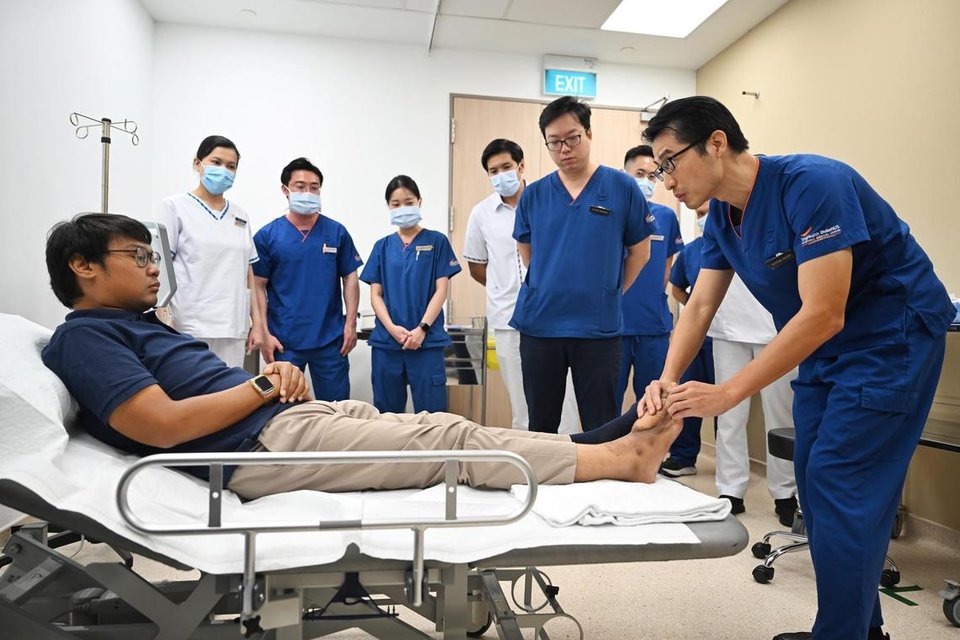Tools to invoke the senses

Published on
09 Jun 2015
Published by
The Straits Times
People who are overly sensitive or not sensitive enough to stimuli can act in ways that are problematic, so hospitals have dedicated rooms for therapy
Over the years, 35-year-old graphic designer Vivian Lim noticed that her son was growing up differently from his sister, who was a year older.
Isaac made no eye contact with people and was exceptionally sensitive to his environment.
If the vacuum cleaner was switched on or if an object hit the floor loudly, he would cover his ears and run from it. He also did not like others touching his head, so it was difficult to wash his hair.
Yet, he actively sought out certain stimuli and would get overly excited when watching his favourite shows.
When Isaac got upset, he would sometimes bang his head against the wall.
To the untrained eye, he was simply behaving badly. But, in fact, he was born exceptionally sensitive to his environment and, for people like Isaac, the world can be a fearful and challenging place.
Five-year-old Isaac has autism, a condition where up to 90 per cent have unusual sensory responses.
People with autism may be over- or under-sensitive to environmental factors such as images, sounds, taste, smells, touch and movements.
For more than two years, since he was diagnosed at three, Isaac has had weekly sessions with Ms Esther Tai, a senior occupational therapist at National University Hospital's (NUH) Rehabilitation Centre. She helps him to organise sensory information better.
His father, Mr Tong Beng Wee, a 43-year-old sales manager, said his son now tells them when noise bothers him, instead of running away or tugging at their clothes.
The session allows patients to explore their senses and learn about types of stimulation in a controlled environment.
Such multi-sensory stimulation was first introduced to people with learning disabilities.
But its use is becoming increasingly popular for other groups of patients, with at least two hospitals here setting aside space on their premises for the therapy.
These rooms contain objects that stimulate the five senses, such as fibre-optic cables, aromatherapy lamps, water columns of different colours, textured balls and screen projections.
At the Institute of Mental Health (IMH), four sensory rooms have been set up since December 2013 for different groups of patients.
Dr Tan Bhing Leet, head of IMH's occupational therapy department, said it was also around this time that the institute started having more occupational therapists trained in sensory-based interventions, one of several ways to address challenging behaviour without medication or physical restraint.
Six years ago at NUH, a section of its Rehabilitation Centre in the main building was dedicated to sensory therapy for children and adults. Since 2013, adults have their own space in another rehabilitation centre.
SEEKING OUT STIMULATION
People unconsciously seek sensory stimulation through the choices they make every day, such as the movies to watch and the food to eat.
For people with sensory processing difficulties, in particular those with intellectual disabilities or autism spectrum disorder, parts of their brains do not get sensory inputs accurately or adequately, said IMH's principal occupational therapist, Mr Ashley Jayapaul.
The result is that they have trouble functioning in their daily lives or other people may deem their behaviour inappropriate.
Some patients may avoid standing close to people, while others touch people to the point of irritating them.
And a child who slumps in his seat in class may be trying to seek tactile sensations, though this can be misconstrued as inattentiveness.
At IMH's multi-sensory room, which opened in April last year, patients can wrap themselves in a weighted blanket, run their fingers across a tactile board on the wall or play with fidget toys to fulfiltheir need for tactile stimulation.
Even the lights in the room can be adjusted to help patients overcome their aversion to brightly lit areas.
Ms Tai said the onus is on caregivers to find ways to fulfil patients' sensory needs. For example, sitting on an air-filled cushion may fulfil a need to rock oneself.
At NUH's Rehabilitation Centre and IMH's Sensory Integration Gym, occupational therapists also work on patients' awareness of the position and movement of different parts of their bodies, known as vestibular balance and proprioception. This is done using swings, balance boards and a mini-rock wall.
For instance, during Isaac's therapy last Friday, Ms Tai tasked him with collecting toy animals from the floor while suspended, face-down, on swings that hang from the ceiling.
Earlier this April, IMH opened a cool-down room, named The Iceberg, in its 20-bed ward for children and adolescents aged seven to 18.
Young inpatients can ask to use the 17 sq m room or are taken there by healthcare staff when they are distressed, which can manifest as screaming, crying or rapid breathing.
The children get to lie on a hammock or beanbag, hide under a tent, doodle on a whiteboard and read self-help books.
When they have calmed down, the caregiver helps them process what has happened by talking them through their emotions.
Said Ms Haanusia Prithivi Raj, IMH's senior clinical psychologist: "It is normal and perfectly acceptable to feel all emotions, including anger and sadness. However, we want young people to respond to such emotions in healthier ways."
This strategy helps to reduce the likelihood of self-harm or aggressive behaviour. It is also hoped that the coping skills they learn can keep them from future hospitalisations, she said.
ELDERLY WITH DEMENTIA
Another group of patients who have issues responding to stimuli are elderly people with dementia.
The progressive neuron losses that occur in dementia leads to impaired processing of sensory stimuli, such that dementia patients may become confused by the sounds and activities in a hospital ward.
Ms Carmel Tso, IMH's principal occupational therapist, said the ageing process also weakens a person's five senses.
Patients who have lost the ability to speak may engage in disruptive behaviour to express themselves - pull their hair, shout, rummage through cabinets and wander around.
It is not ideal for them to be left alone for prolonged periods with nothing to do, as this deprives them of stimulation.
Barring them from their leisure activities, for instance, may worsen the problem, said Ms Eng Jia Yen, principal occupational therapist at NUH Rehabilitation Centre.
She has seen bedridden patients throw pillowcases around and strip themselves to gather sensory inputs, all the while leading their caregivers to mistakenly think they are being difficult.
In such instances, placing them in a multi-sensory environment may help dementia patients strike a balance between stimulating and relaxing activities, said Ms Tso.
IMH's sensory room for dementia patients, set up in a 50-bed ward, is stocked with sensory-stimulating items, such as a bubble tube, an activity apron and an activity tray.
A patient can sit next to the bubble tube on a rocker chair and watch toy fish move in the column of liquid, feel the slight vibrations of the tube when they touch it, and rock themselves gently on the chair.
"A simple way to find out what types of sensory activities are suitable is to observe the person's responses to everyday activities, or to make references to what he had enjoyed previously," said Ms Tso.
For example, someone who enjoyed cooking and gardening may derive pleasure from tactile-based activities, while another who walks regularly may prefer activities that involve movement.
Both NUH and IMH declined to reveal exact costs. Spokesmen for both hospitals said the cost of therapy depends on the activities done with the patient and the duration of the session.
A review of multi-sensory stimulation for people with dementia, published in 2012, reported immediate positive effects on their behaviour (fewer disruptions) and mood, though there is no conclusive data about its long-term effectiveness.
Research has also shown that such intervention is not restricted to a room, but can be implemented at different settings and during contact with patients, Ms Tso added.
Agreeing, Dr Tan said the effectiveness of the treatment depends more on the appropriate use of equipment, rather than the mere set-up of such rooms.
Tips for caregivers
CARING FOR A PERSON WITH SENSORY PROCESSING DIFFICULTIES
1. Present alternatives: Do not force someone who displays fear or distress to participate in an activity.
Instead, present some alternatives, observe his responses and use that to guide you on what he may accept.
2. Accept fluctuations: Be aware the person may fluctuate between embracing and rejecting the same stimulus at different times.
3. Create safe activities: Sensory seekers tend to look for ways to move, jump, fall, crash, kick and push, which may endanger themselves or others.
Think of ways to satisfy these needs through safe and fun activities, such as bowling or jumping on a trampoline.
4. Massage to relax: A person who is sensitive to certain sensations - sounds, lights, smells - may like activities that provide intense deep pressure to the skin, joints and muscles.
These activities generally calm him down, so you can consider giving someone like this a massage.
5. Beware over-stimulation: Watch for signs that the person is over-stimulated, such as when he giggles non-stop, becomes extremely active or turns inattentive.
If you note these signs, stop the activity immediately and, if necessary, calm him down by wrapping him up in a blanket, rocking him very slowly, giving him a big bear hug, keeping him snuggled in a big comfy chair or putting him in a warm bath.
6. Stay organised: Keep routines and possessions organised. If changes are to be expected, let the person know in advance. You will have to experiment with how early someone needs to know.
7. Do not reduce movement: Do not punish the person by keeping him from activities that involve movement - for example, taking away playground time for not sitting still at the table during dinner. By removing it, you might simply have a more difficult child to deal with later.
INCORPORATE SENSORY INPUT INTO DAILY ACTIVITIES
1. Bath time: Scrub the body with a washcloth or brush; try a variety of soaps and lotions; put shaving cream or bath foam on the wall and play with it; rub the body with lotion after bath time as a form of massage; or sprinkle powder onto the body and rub it into the skin.
2. Cooking: Let the person mix the ingredients, especially if it will help work his muscles. For example, let him mix and roll dough and then push it flat. Allow him to help to carry pots and pans, bowls of water or ingredients under supervision.
3. Grocery shopping: Have the person push the shopping cart, carry the groceries and help put them away when you get home.
4. Mealtime: Encourage the person to eat chewy foods and drink out of a straw.
Try having him sit on an air cushion to allow some movement. Use weighted lap blankets to keep him calm and still.
5. Household chores: Allow the person to help with vacuuming, moving of furniture, and carrying of the laundry basket or detergent.
6. Play time: Read books in a rocking chair or while lying in a beanbag.
7. Listen to soft music.
8. Prepping for appointments: Provide heavy movement activities or massage the head before visiting the dentist or hairdresser.
TYPES OF SENSORY ACTIVITIES FOR A PERSON WITH DEMENTIA
1. Use mobile chairs: Push them in a wheelchair or let them sit in a rocking chair.
2. Use a massage chair: It can provide tactile stimulation.
3. Have an aquarium: An aquarium, with its constant movement of fish and the soft purring of the motor air pump, can provide visual and auditory inputs.
4. Activity apron: One that has little trinkets sewn on, such as bells, zips, buttons, and textiles stuffed into the pockets for the person to rummage through, can stimulate his sense of touch, hearing and sight.
5. Use of scents: Familiar scented creams or toiletries, flowers and spices can stimulate his sense of smell.
6. Set tasks: Set him household tasks, such as sorting out cutlery.
7. Know what he likes: Know his likes and dislikes, so you can plan activities accordingly. An avid cook can help by peeling garlic, or simply be in the kitchen to take in the sights, sounds and smells of food being prepared.
Source: The Straits Times © Singapore Press Holdings Limited. Reproduced with permission.
ALL views, content, information and/or materials expressed / presented by any third party apart from Council For Third Age, belong strictly to such third party. Any such third party views, content, information and/or materials provided herein are for convenience and/or general information purposes only. Council For Third Age shall not be responsible nor liable for any injury, loss or damage whatsoever arising directly or indirectly howsoever in connection with or as a result of any person accessing or acting on any such views, content, information and/or materials. Such third party views, content, information and/or materials do not imply and shall not be construed as a representation, warranty, endorsement and/or verification by Council For Third Age in respect of such views, content, information and/or materials.







